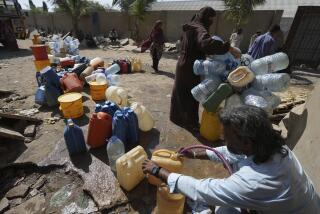Simple Technology Works in Third World : U.N. Water Project Runs Best on Basics
- Share via
THE HAGUE, Netherlands — The way to cleaner water in the world’s poorest countries may be inexpensive and old-fashioned.
Pumps that are hand-operated rather than electrified, for example, could be a major weapon in the fight against disease-infested drinking water in the Third World, aid workers say.
The possibility that the way forward does not necessarily lie in costly high technology has given new hope to policy makers as a 10-year U.N. campaign for clean water draws to a close without achieving its goal.
“Thirty-five thousand people, most of them children, die every day all over the world from water-related diseases,” said Sandy Rosival, a leading delegate at international talks here recently on drinking water and sanitation in the Third World.
“That’s like four jumbo jets crashing every hour. . . . It’s not only unacceptable, it’s immoral,” said Rosival, an American who heads the U.N. Water and Sanitation Decade, launched in 1980.
But, while the U.N. effort has failed in its goal of giving clean water to all by 1990, important lessons were learned that enabled experts to reassess their strategy.
In the past, policy makers and technicians in developing countries tended to seek high-technology answers dependent on heavy financial backing from governments.
But trials showed that cheap, locally produced manual pumps met water needs more effectively than complex electrified systems.
“It’s taken us eight years to realize that the only systems that can really work must be set up and maintained by the community they serve,” Rosival said.
“When an electric pump breaks down, it may take six months to get spare parts to some remote villages, so people just go back to drinking from rivers and water holes,” Rosival said.
Other examples of low-cost, easy-to-use technology included hand-built latrines and the use of sand to filter water.
“We have not yet made a major breakthrough in terms of giving people a better service, but we have learned the key to future progress lies in low-cost, locally funded projects,” he said.
Rosival said such affordable solutions were also essential because Western nations were unlikely to boost their meager 15% contribution to total investment in Third World water supply.
“At the start of the decade we estimated it would require $600 billion to ensure an adequate water and sanitation service to all Third World towns and villages,” Rosival noted. “Now we realize that using appropriate low-cost technology we can provide the same service for $200 billion.”
Tanzanian Water Ministry official Nerei Msimbira, one of 60 aid agency and government representatives attending the talks, agreed that the main achievement of the last 8 years was a change in attitude.
“Before the ‘80s I would never have thought of introducing such a simple thing as a hand pump . . . Now people in my country are crying out for them,” said Msimbira, adding that technicians used to believe sophisticated pipe systems were the answer to Tanzania’s chronic water supply problems.
But Msimbira said many Third World governments still failed to grasp the far-reaching social and economic effects of poor water and sewage systems.
Rosival noted that untold numbers of people are paralyzed in central Africa and India each year after drinking from wells contaminated by a parasite.
While only temporary and not deadly in itself, this disease severely cut food supplies because it tends to strike at harvest time, incapacitating most of the work force.
“A UNICEF study in Nigeria has shown that the rice harvest was reduced by more than 20% in one year” in affected areas, Rosival said.
More to Read
Sign up for Essential California
The most important California stories and recommendations in your inbox every morning.
You may occasionally receive promotional content from the Los Angeles Times.










